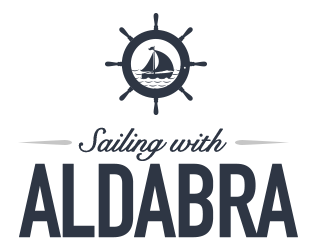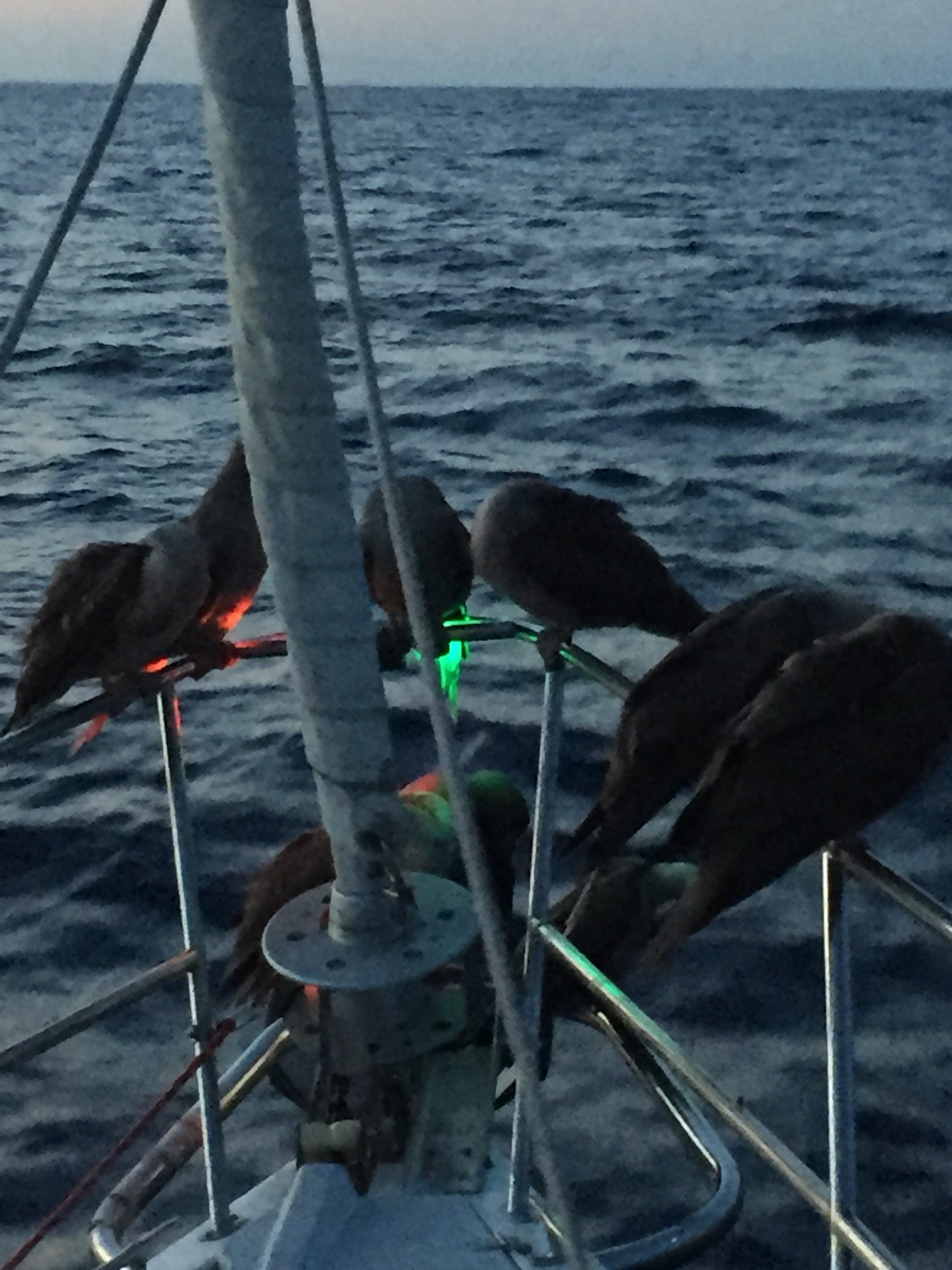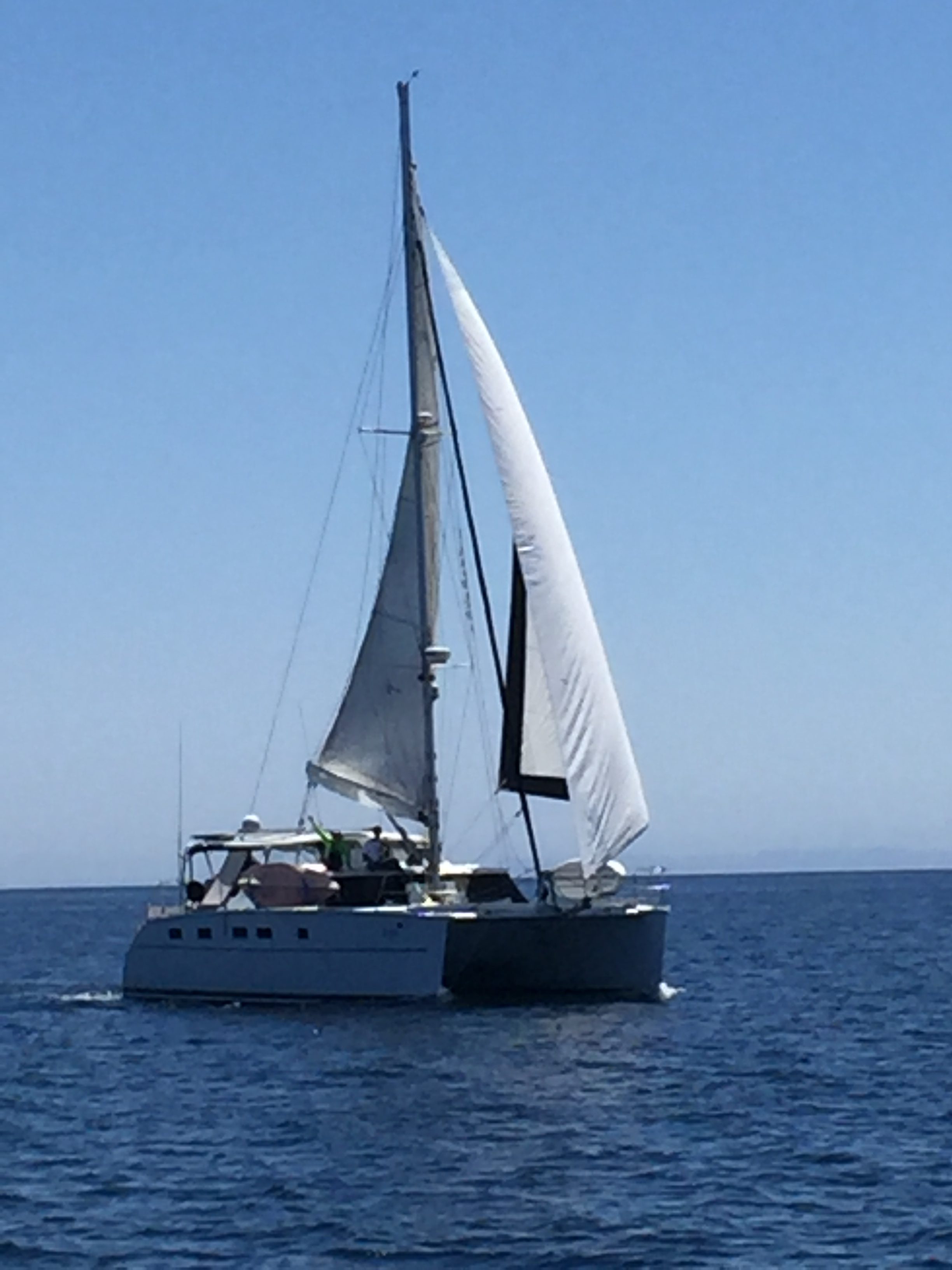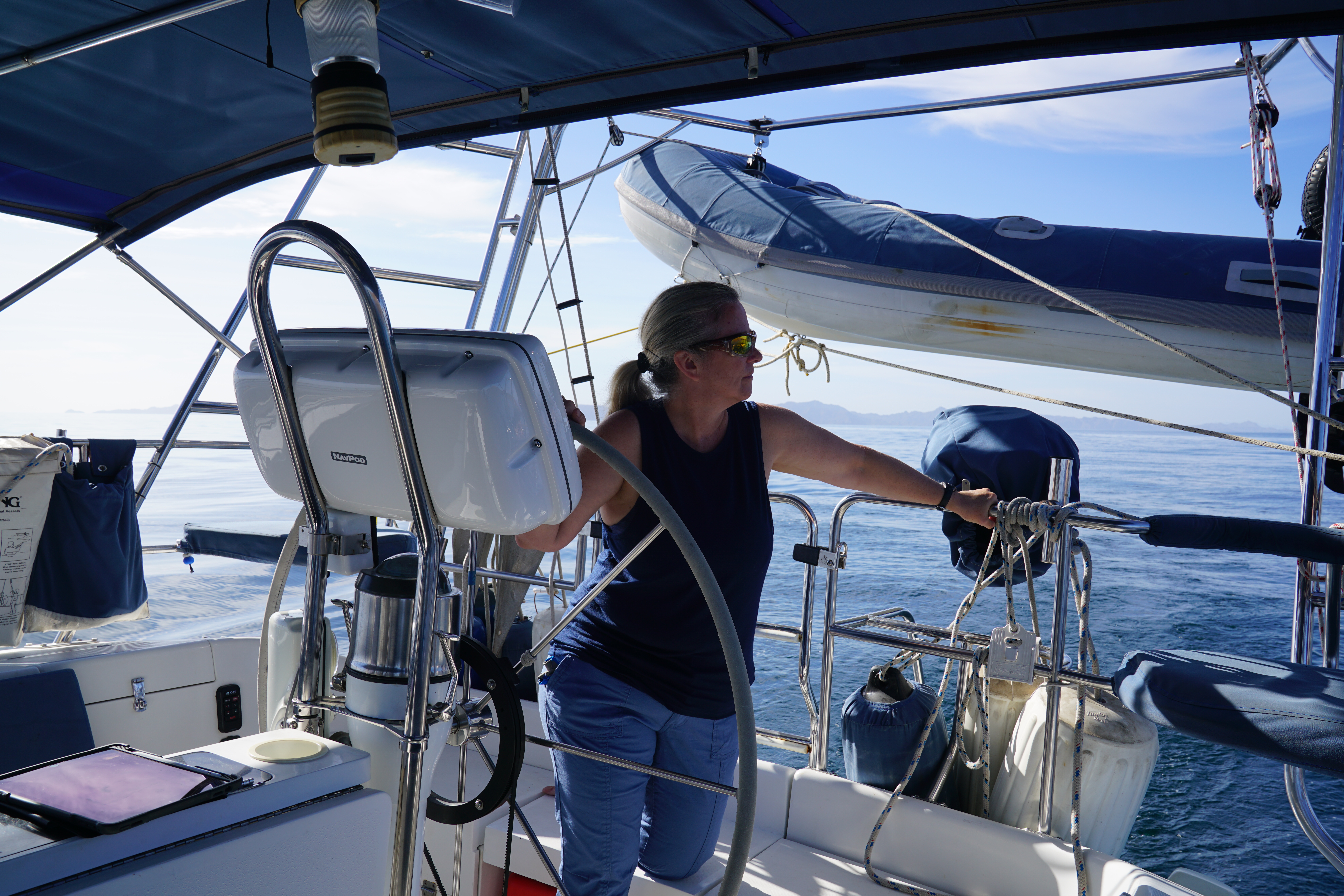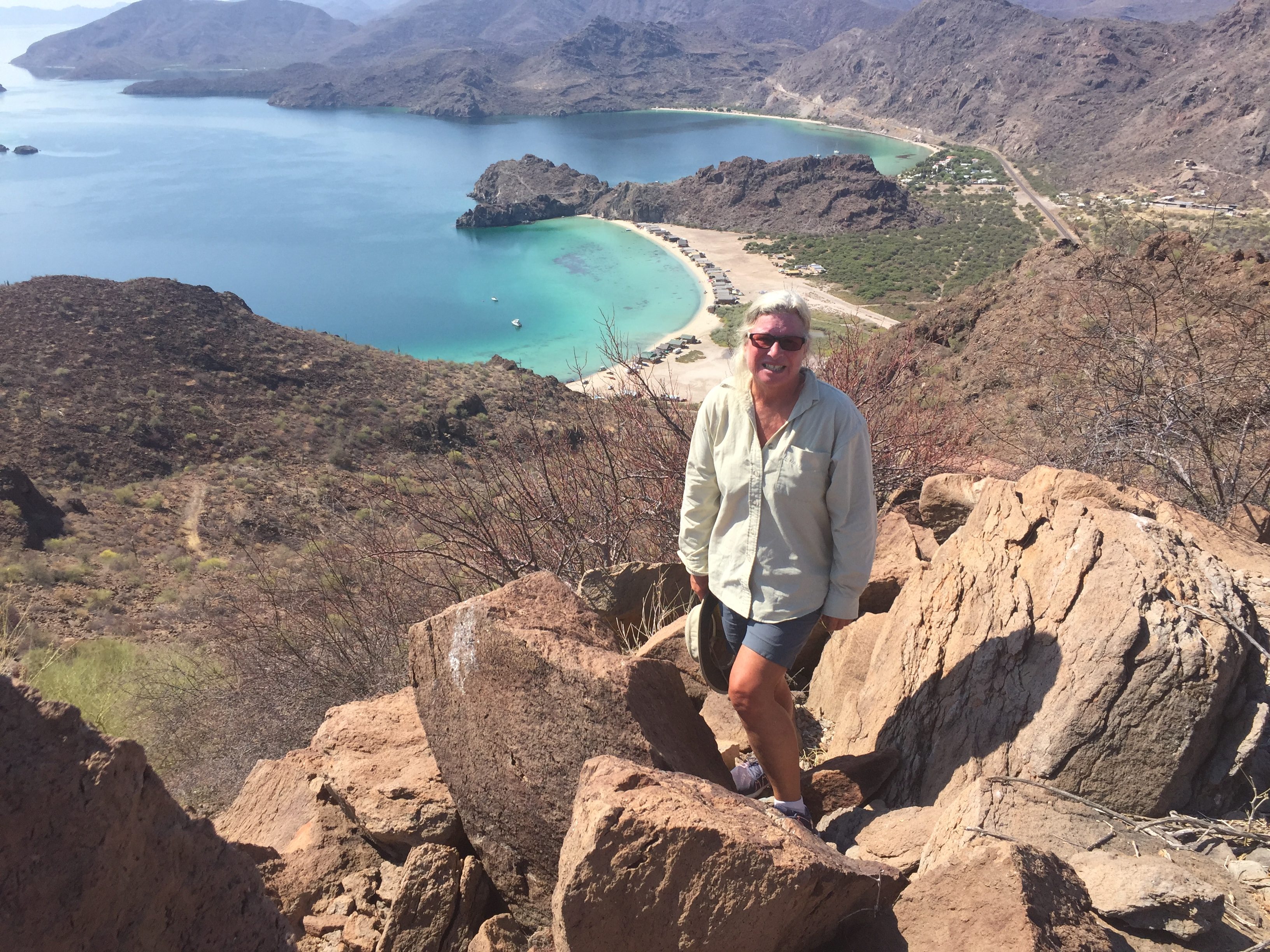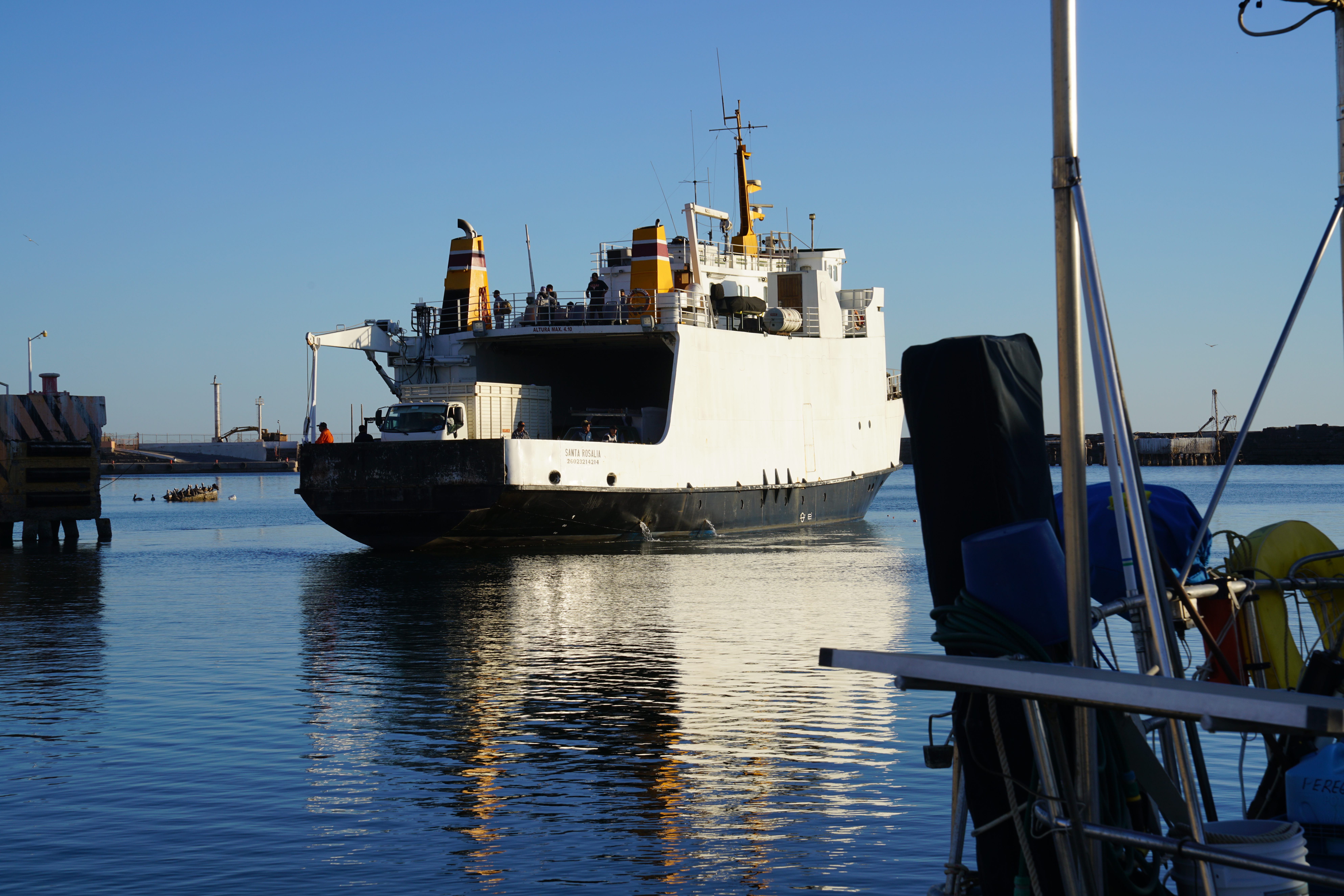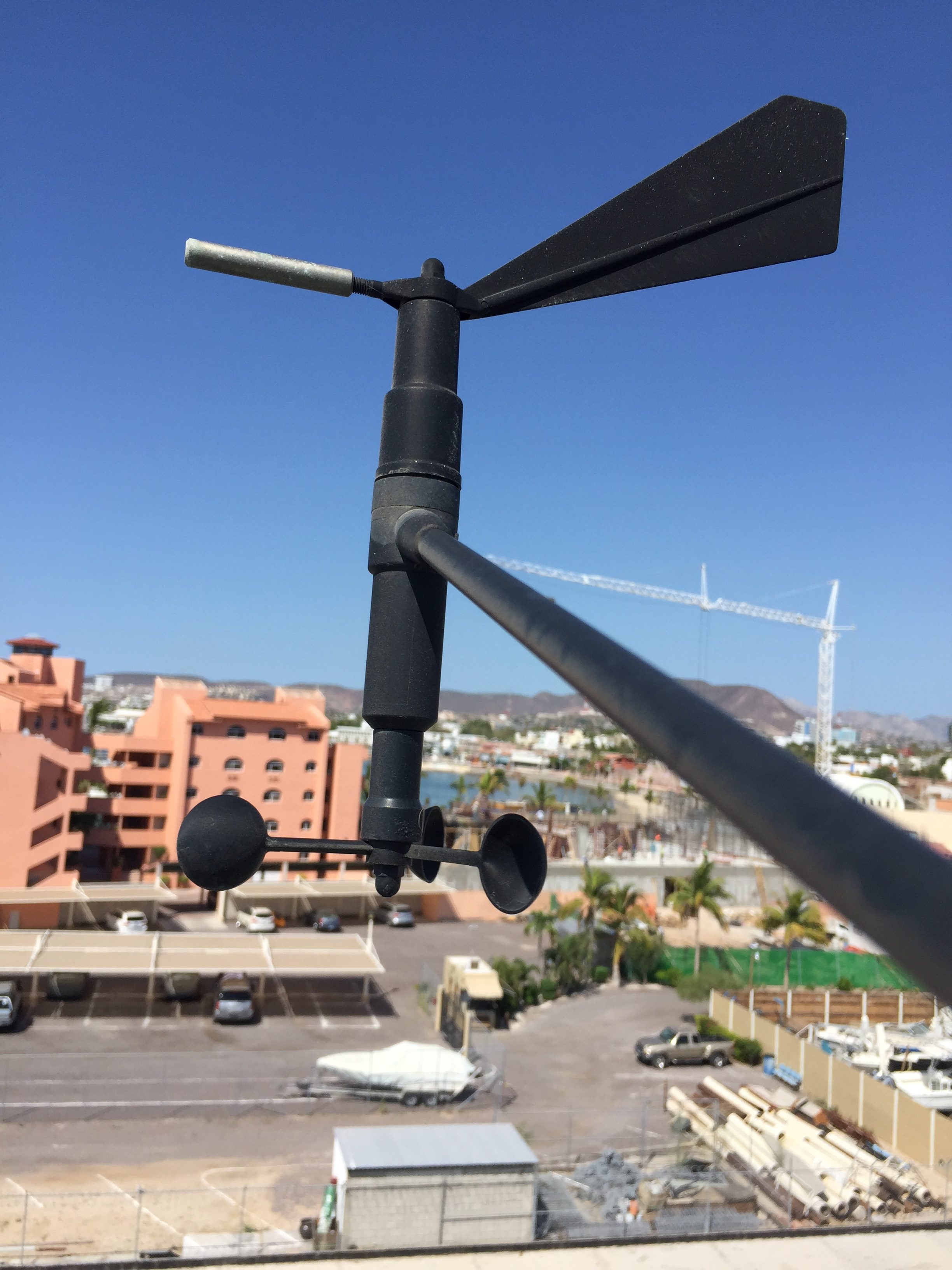I Just arrived in San Diego after putting Aldabra away for the hurricane season in Paradise Village Marina in Nuevo Vallarta, Banderas Bay, Mexico. It took more than a week to prepare the boat. I had to strip the exterior of things that could get damaged or cause damage during a big blow. Down below, I went bow to stern, clearing out gear, cleaning compartments and then restowing the gear. I also pickled the watermaker and changed the engine oil, flushed the dinghy motor with fresh water, and lashed the dinghy upside down on the deck. The task list also included defrosting the refrigerator and freezer and giving away most of the food still onboard. The final steps were to close all the hatches and cover them from the inside with aluminum foil, and install the dehumidifier (thanks to Jeff from El Gato). After that, the boat was like a sauna, so I packed up my luggage and headed for the airport. (I was looking forward to some relief from the heat and humidity.)
I had arrived in Paradise Village on July 2 with crew Stephen Hardt after crossing the Sea of Cortez from La Paz. We left at 4:00 p.m. on Friday June 29 (I forgot that we supposed to leave on a Friday) and sailed or motor-sailed for three nights and two days. We had 1-2 meter swells the whole way across and a variety of wind conditions. During the last third of the trip, the wind came from behind but it was too light to fly the spinnaker, which we’d set up on deck in anticipation. We saw some wildlife (turtles and dolphins) but most notable were the 15 brown boobies that hitched a ride on the bow pulpit for an entire night and made quite a mess.
It was a good spring in the Sea of Cortez. It started with a week-long visit with my sister Wendy, her husband Pat and my niece Lizzie. We traveled north to Isla San Francisco and then backtracked to Isla Partida and Isla Espíritu Santo, then to Puerto Balandra and back to La Paz. It was early in the season, plus it was an unusually chilly season, so the water was cold, the anchorages were very windy, and we had only one really good sailing day. We enjoyed Ensenada de la Raza on Espíritu Santo. We explored by dinghy and kayak and watched the turtles and the grebes in their daily routine. I hope they had a good time but the conditions were not optimal.
Once back in La Paz, I spent time playing with good friends who had arrived in La Paz on their boats (Tom and Helen on Catatude, Jeff and Jules on El Gato and John and Donna on Carmanah). And I got some modifications done to Aldabra. (The arch and davits installed last summer needed to be made stronger.) And of course no time spent in a marina is without chores, such as cleaning, changing the engine oil, defrosting the refrigerator and freezer, shopping for provisions, and regularly checking the weather. Then on Tuesday, April 10, I headed north, back into the Sea of Cortez, this time single-handing the boat in the company of buddy boats. We knew a strong northerly wind was coming so we traveled rather quickly, first to Isla San Francisco and then to Agua Verde, where we rode out the northerly quite comfortably. (I had thought it would be good to get to Puerto Escondido for the northerly, but my friends on Carmanah suggested that Agua Verde was the place to be. I later learned that the folks in Puerto Escondido had a miserable time of it. In Agua Verde, we hardly noticed anything as we hiked and played bocce ball on the beach.)
Leaving Agua Verde began a two-month buddy-boating excursion in which Aldabra and El Gato were inseparable. We stopped in Puerto Escondido where I was joined by crew Katie for 10 days. We then went north to Isla Coronados, San Juanico, and Bahía Concepción. We saw whale sharks swimming around Playa Coyote and did some kayaking and hiking. Katie departed from Bahía Concepción and caught a car ride back to Loreto to catch her flight, while Aldabra and El Gato continued north to Punta Chivato and then Santa Rosalía.
By the time we got to Santa Rosalía, I had become comfortable with anchoring by myself and I successfully picked up a mooring ball in Puerto Escondido. But I was quite nervous about going into a marina, especially one I hadn’t entered before. Plus it was quite windy. So Jeff and Jules took El Gato in first and got situated. I then followed, talking to Jeff on the radio. They had plenty of dock hands waiting so entry into the slip was smooth. The marina at Santa Rosalía is small and friendly and the town has some charm. We spent a few days getting our boats back in order, doing laundry, eating out and reprovisioning.
Then we were off again, north. We stopped in Bahía San Francisquito and then Ensenada el Alacrán. There is an eco lodge there and we visited with the guests and did some hiking. We were there for two or three days with a lot of wind. We finally broke free and continued on, up into Bahía de Los Angeles.
Bahía de Los Angeles had been the goal. We’d heard so much about its beauty. And it was beautiful. But we were there during a pretty significant red tide, and the water was cold and the anchorages windy. We were chasing some magical experience that wasn’t happening. We did anchor at a couple of the islands and walked around the volcano on Isla Coronado (aka Smith). It took us four and a half hours to go around, bouldering for more than half of it. We were very glad to get back to where we’d left the dinghy.

Aldabra, El Gato and Pincoya Anchored at Isla La Ventana. The Village of Bahía de Los Angeles Is Off in the Distance
From there, we headed north again to Puerto Refúgio, at the northern tip of Isla Angel de la Guarda. The trip north started out calmly enough, although I reefed the main in anticipation of wind, a first for me since arriving in Mexico. We were sailing pleasantly on a reach until about halfway up, when the winds and the seas built quickly. Both of our boats had too much sail area up. El Gato had an issue with their headsail, which limited their maneuverability and I found it hard to round up into the wind to drop my main. The wind was coming from behind and I wanted to sail with just my jib. The first step to dropping the main was to furl the jib, and while doing so, I lost control of both jib sheets. (I know, where were those figure 8 knots?) The problem was both boats were getting too close to each other, so I had to act. I turned on the motor to get myself into the wind, and the jib sheets wrapped around the prop.
After quickly turning off the motor, I went forward and cut the jib sheets free, dropped the main, and then rigged up new jib sheets to continue the journey with just the jib, sailing at 6 to 7 knots in 25+ knots of wind. Meanwhile, El Gato fixed their issue and sailed on ahead. They anchored on the west side of the island and launched their dinghy. Jeff then lashed his dinghy to my boat as I approached in case I needed help anchoring. We each took a turn at diving in the 60-degree water to free the lines from the prop. The jib sheets had fused with the rubber of the cutless bearing and pushed it about a half inch forward of the strut. But we got enough of the lines free so that I could motor east the rest of the distance around to where we would anchor for the night.
I soon realized that the force of the jib sheets on the shaft had caused problems with the stuffing gland, which had just been repacked in March. I was taking on more water than I should. Jeff was kind enough to repack it and we continued to make adjustments over the next couple of days. It was still leaking too much water but I was able to use the motor. And in the coming days I gained confidence that I wasn’t causing additional damage.
Puerto Refúgio, although it had cold water, was beautiful. We had good hikes on the main island and visited a nearby island with a sea lion colony. We were in the company of Gene and Gloria on Pincoya, and enjoyed a couple of nice evenings with them. We had one night there with really intense winds, the most I’ve experienced in Mexico. I thought my wind generator was going to explode but I thought it might be too dangerous to try to tie it down. It was a long, noisy night. None of us, El Gato, Aldabra nor Pincoya got a true reading of the wind speed that night, but it was remarkable.
The sail back south to Bahía de Los Angeles was quite nice. I was afraid that I might not be able to use my motor, so I left early and tacked back and forth. The wind angle eventually became favorable so I was able to stay on course on a single tack. And when the wind eventually died, I was able to motor back to the anchorage in front of the village. After a day or so, we headed back south, stopping at Punta el Pescador and then Bahía San Francisquito, where we met Adam and Jessica on Volare. We hiked all the way around the bay and then later paddled around.
We continued on to Santa Rosalía, Punto Chivato, Bahía Concepción (three different anchorages), San Juanico and Loreto. In Loreto, we anchored off the town and attended the Chocolate Clam Festival with our friends Tony and Diane from Dolce, and new friends Linda and Ken from Linda Marie and Chris and Annette from Wishlist.
Then it was time to head south. We tried to stop at Nopalo because we never had, but it was too windy so we headed straight to Bahía Candeleros. Jeff and Jules and I took a long hike there and went swimming. The next stop was an overnight at Agua Verde, where we explored the east anchorage in the dinghy and had fish tacos at the palapa on the beach. We then continued on to Puerto Los Gatos for a night, where we took a nice hike up the hill on the north end of the anchorage.
On Friday, June 8, we went south to Bahía Amortajada on the southern end of Isla San José. We took a dinghy ride into the estuary and celebrated Jeff’s birthday with a carrot cake. It was a calm night, but the next morning brought a significant south swell and we went in search of a new anchorage. We ended up on the northern end of Isla San Francisco, which was the best protection we were going to get from the south swell and southerly winds. We took a hike up to a saddle where we could see the other two anchorages on Isla San Francisco, with very few boats, which is quite unusual. The southwestern anchorage is usually packed.
The next morning we headed south to Puerto Balandra, on the Baja Peninsula near La Paz. It would be our last anchorage before heading back to La Paz and civilization, and it would signal the end of our journey together. While in Balandra, Jules and I took a significant hike in the surrounding hills and the three of us went in the dinghy to a restaurant about a half hour a way. It was on Tecolote Beach, so crowded with tourists it was hard to find a place to land the dinghy. It was a crazy scene but the food was good.
From Balandra we stopped at Marina CostaBaja for fuel, where I was able to dock on my own without incident. And then it was back to La Paz, where we settled into Marina Cortez, just in time to be sheltered during Hurricane Bud, which by the time it arrived was just a bit of wind and a light rain.
On Monday, June 18, Jeff helped me take Aldabra over to the Palmar boat yard, where she was hauled out for four days. I stayed in an air conditioned room at Posada Luna Sol while the work was done. She had her cutless bearing replaced, new bottom paint, and the stuffing box was repacked.
During that time, I also said a temporary farewell to El Gato. They were headed back across the Sea to Nuevo Vallarta. We had shared every evening meal together since leaving Agua Verde in mid-April. We’d taken dozens of stunning (and hot) hikes together. And they were my support when the conditions were challenging. We’d also watched an episode of Orange is the New Black each night. We still had two episodes left of Season 3, but they would have to wait until we were all back together in Nuevo Vallarta.
Aldabra went back in the water on the morning of Friday, June 22, with help from Doug from Spartan. I got situated in Marina de La Paz and then later walked downtown to the bus station to meet my old friends David and Susan Rose. We set off the next morning to spend some time in the anchorages of Espíritu Santo but had to quickly turn back to the marina with an overheating engine. Instead, we spent the day replacing a shredded impeller and cleaning out a hose that might have harbored impeller debris. (Before I hauled the boat out, I should have closed the raw-water intake to the engine. What I believe happened is that the impeller dried out while the boat was on the hard.)
Confident that the engine was running smoothly, we set back out the next morning and enjoyed Sunday night at Caleta Partida and Monday night in Puerto Balandra before heading back to La Paz for their last night. At Caleta Partida we took the dinghy through the cut (my first time doing this) and explored south. In La Paz, I made them hoist me up the mast so I could check out my wind instruments that weren’t working. It was a quick but nice visit before they had to return home to finish preparing for their daughter’s wedding in August.
Once David and Susan left, I had a little more than a day to get ready to cross the Sea of Cortez. Crew Steve would be flying down the next day. He very kindly drove all over Santa Cruz collecting the parts I needed. A new wind instrument, a new wind vane and a new chart plotter. When he arrived, we installed the chart plotter and La Paz electrician Will Imanse came over and climbed the mast to install the wind instrument and vane. We had some configuration issues up until minutes before leaving, but we departed just ten minutes later than planned.
